By 1781, the Revolutionary War in and around Ninety-Six had eroded into a series of vengeful retaliations between neighbors and families that had more to do with personal disputes and profit than any military objective. Frontier farmers, like John Miller** (1748), that had served in Patriot militias were often the targets of marauding bands of British loyalist (“Tories“) and/or Indian warriors. For protection, these frontier farmers formed small militia companies based in the individual farms or seized plantations known as “stations” at strategic points within the frontier settlements in the back country of South Carolina.
John Miller** (1748) was the 4th-Great maternal
Grandfather of Eula Claudine Reed.
At the outset of the American Revolution (September 12, 1775), John Miller and his brother Andrew Miller had joined 54 of their back country neighbors to publicly pledged to serve in the (patriot) militia of the newly formed “Council of Safety” for the Ninety-Six District of South Carolina. “As a troop of horse”, they agreed to hold themselves ready to respond within “24 hours’ notice” under officers they elected “to defend our country in her liberties from any invasion”. Other members of the newly formed militia “Rangers” were John Norwood, David Hunter, James Morrow, Moses Liddell, John Johnson, James Stevenson, Hugh Stevenson, John Stevenson, Alexander Stevenson, William Miller Sr, William Miller Jr, David Miller, Robert Miller, John Calhoun, and Harris Tyner (see below).[1]
- James Stevenson is believed to have been related (possibly a brother) to John Miller’s first wife Lucinda Stevenson. John Johnson (Johnston?) may have been married to John Miller’s sister.

Copy of the original declaration of residents of the “Ninty Six District” dated September 12, 1775. On the second page, the name of John Miller was listed after the names of his brother Andrew Miller, James Stevenson, and Harris Tyner; and above the names of Robert Miller, Steven Stephons, William Ross, Calib Tyner, and John Johnson (South Carolina Archives Series S213089, Box 2, Folder 6).
“We the underwritten subscribers being deeply affected at this time on account of the present inovation that of late have taken place and still seen to be continued between Great Britain and the American Colonials and also being well convinced that great precaution ought to be used by every person in supporting and maintaining our rights and privileges which we are entitled to as being free born according to known laws of nature and nations, and further being so situated that an extended tract of land within the limits of this province lays much exposed to the executions of an Indian enemy, should the present seeming ill disposed minds of those savages be disturbed by any ill disposed person who wisheth ill to the common peace and tranquility of the British Empire and being fully minded to do every-thing in our power consistent with the obligations that we lay under to our country in general and to ourselves as free men and to our posterity–
We and each of us for ourselves do unanimously agree and into strict compact enter as one man with heart and hand to defend this country as for, as in us lays, and that the same may be effected in the most salutary way at the least cost to this province or America in general, we do hereby engage to furnish ourselves with good arms and accoutrements, and also to hold ourselves in readiness as a troop of horse to march at 24 hours notice under the command of our proper officers —- by the honorable, the council of safety, and that the world may be fully satisfied of our loyal intentions, we propose to defend our country in her liberties from any invasion and paid by the government. And we also further agree that as soon as 30 men or more well equipped have entered and subscribed their names hereunto, then we hold it most proper to choose our officers by a majority of the votes of the volunteers so entered – to which we engaged to perform truly given under our names this 12th day of September 1775.“
John Miller’s brother, Andrew Miller, served as a first lieutenant and James Stevenson served as second lieutenant in the “Little River” patriot militia under Captain David Hunter in 1775 (Jared Liddell served in the company).[2] When Captain Aaron Smith and his family were killed by Cherokee warriors in July 1776, Andrew Miller was named Captain of the “Little River” militia company of “rangers“. Captain Andrew Miller continued to command the company until he was killed while leading the company at the Battle of Cowpens on January 17, 1781. Following the battle, Captain John Norwood assumed command of the “Little River” militia company of “rangers” until the end of the war.[3]
Conversely, after John Miller’s and Andrew Miller’s close neighbor Harris Tyner enlisted as a “ranger” the newly formed “Council of Safety” arrested Harris Tyner and imprisoned him for believing he was a British Loyalist. This may have been due his close ties with the Cherokee as Harris Tyner (likely a trader) frequently travelled “between the Cherokee villages and the frontier settlements“.[4] After his release, Harris Tyner changed his allegiance and fought as a British Loyalist along with his brother Caleb Tyner and several members of his family.[5]
- Prior to the start of the revolution, Harris Tyner’s land bordered the land of John Miller on one side and the land of Andrew Miller on the other side. Likewise, the land of Harris Tyner’s brother Caleb Tyner bordered John Miller’s land on two sides while another brother (William Tyner) shared a land border with Andrew Miller.
In 1781, John Miller (1748) was living with his family on a frontier farm “on the waters of Little River“[6] about a mile away from the home of Joseph Pratt. Joseph Pratt operated a grist mill (“Pratt’s Mill“) on the Little River, just above where the Little Hogskin Creek empties into the Little River (about eight miles northwest of present-day Abbeville). Other families living nearby were John Lindsay (Lindsey), Samuel Lindsay, Hugh Reid, Robert Ellis, Andrew Webb, James Brownlee, and John Johnston (Johnson?).
- Hugh Ried was a witness to the will of John Miller (1748).
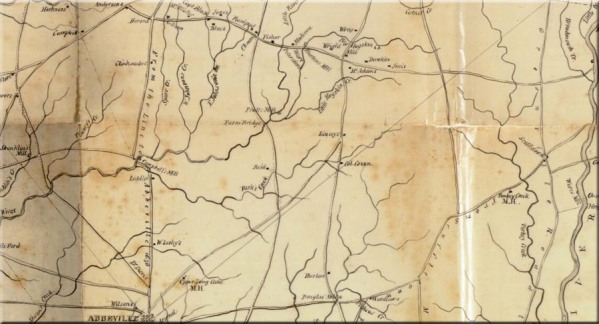
Pratt’s Mill as Shown on the 1825 Robert Mills Map of Abbeville District of South Carolina.
After General Nathaniel Green’s Patriots failed siege of Ninety-Six, General Green withdrew in June 1781. In July, Lieutenant Colonel John Harris Cruger withdrew the last organized British Loyalist forces from the area. In August 1781, British loyalist Captain William Cunningham organized a small band of between 30-60 British “Tories” from the area between the Enoree River and the Saluda River. From his base in the Long Cane settlement, Captain William Cunningham and his men “killed eight noted Patriots” living in the area settling personal vendettas.[7]
- William Cunningham was reputed to be a cousin of Long Cane Loyalist leader Robert Cunningham.[8] The daughter of Robert Cunningham’s daughter (Elizabeth Cunningham) married the son of James Brownlee** (1735) (John Brownlee) on May 1, 1782.
In 1775, William Cunningham had enlisted as a private in a Patriot company commanded by Captain John Caldwell in Colonel Thompson’s Regiment of Rangers (South Carolina 3rd Regiment). When he was passed over for promotion and William Caldwell (John’s brother) was promoted to Captain, William Cunningham attempted to resign, was court-martialed, and flogged. Humiliated, William Cunningham changed his allegiance to the British embracing an intense hatred of the men he had fought alongside.[9]
One of the Patriots killed by Captain William Cunningham and his marauding band of British Loyalist, may have been Francis Johnson (Johnston). A neighbor of John Miller, Lieutenant Francis Johnson had served in the “Little River” militia “rangers” under Captain Andrew Miller from 1779-1780. In 1780 or 1781, the “Tories” killed Lieutenant Francis Johnson and destroyed his farm leaving his wife Margaret homeless and his children (John, Jennet/Jane, & Isabell) orphans. In 1782 or 1783, Margaret Johnson would “married William Miller who was also a revolutionary war soldier“.[10]
- William Miller (named his son Andrew) may have been a brother of both John Miller and Andrew Miller.
The recent deaths increased the tensions between the families living in and around the Long Cane settlement. Stationed at “Pratt’s Mill“, Captain Norwood’s “rangers” (including Andrew Cowan, David Caldwell, Joseph Pratt’s son William Pratt, & Andrew Miller’s son John Miller) regularly rode patrols between the militia company “stations” often covering the entire 40 miles between the Savanah and Saluda rivers. A young son of John Miller (1748), George Miller recalled the patrols of the “Little River” militia regularly passing by his frontier home and one British Loyalist “had a sword drawn over my own head” due to his family’s support of the patriot cause.[11]
- The daughter of Andrew Cowan, Mary Cowan, would marry the son of James Brownlee (1735), William Brownlee (1770), sometime prior to 1790.
- The Caldwell family was closely aligned to the Brownlee and Richey families. This included the wife (Sarah Caldwell**) of George Brownlee Sr** (son of James Brownlee-1735) and the husband (John Caldwell Richey Sr) of Nancy Ann Brownlee (niece of James Brownlee-1735).
Captain William Cunningham and his band of British Loyalist surprised a company of Patriot militia stationed on Reedy Creek (about 20 miles east of Miller’s Station) on September 3, 1781. The commander of the company of “Rangers“, Captain John Ridgeway Sr, had served with Cunningham under Captain Caldwell in Colonel Thompson’s Regiment of Rangers (South Carolina 3rd Regiment) in 1775. Captain Ridgeway, another officer, and eight privates (including his half-brother William Ridgeway) were killed as the loyalist captured two “blockhouses” (known as Ridgeway’s Fort) the “Little River” militia company had constructed to protect the local settlers just north of the Saluda River.[12]
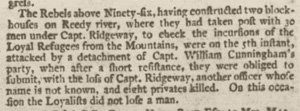
The Royal Gazette (Charleston, South Carolina) dated September 26, 1781, Page 3.
On December 29, 1780, Captain John Ridgeway Sr. had commanded one of three “Little River” militia companies supporting Lt. Colonel William Washington’s Dragoons in the rout of the British Loyalist under the command of Lt. Colonel Thomas Waters at Hammond’s Store (just south of present-day Clinton, about 30-35 miles east of Miller’s Station). The mounted militia under the command of Colonel Joseph Hayes and Lt. Colonel Washington’s Dragoons “drew swords and charged down the hill like madmen“. At the sight of the charge, the loyalist abandoned their lines and “flew in every direction without firing a gun“. The patriots slashed the fleeing “Tories” that had been plundering the countryside, killing 40-150 and capturing 100-200. In his escape, Captain William Cunningham was said to have run “a very fine mare to death“.[13]
On the night of October 3, 1781, Captain William Cunningham’s marauding band had been joined by Cherokee warriors when they surprised a Patriot company posted at “Pratt’s Mill“. The company of “Little River” militia was under the command of Captain John Norwood, another veteran that had served with Cunningham in Colonel Thompson’s Rangers. Although Captain Norwood “was grazed by a ball and was knocked down“, his entire company of “Rangers” quickly scattered into the night eluding capture. Unfortunately, the “Tories” were able to capture 30 horses, saddles, and most of the patriot’s weapons preventing any armed response from Captain Norwood’s company.[14]
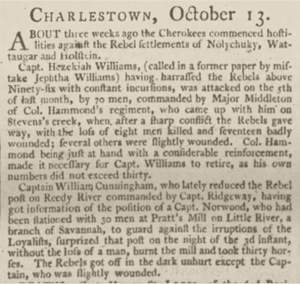
The Royal Gazette (Charleston, South Carolina) dated October 10, 1781, Page 3.
After they burned “Pratt’s Mill” to the ground, the marauding band burned a farmhouse about a mile away that was vacant. Next, Captain William Cunningham and his men raided the farm of John Miller’s brother-in-law John Johnston (Johnson?). The loyalist burned every building on the farm, including the house with John Johnston inside, and captured four young women with three young girls. Although the “Tories” would not allow the Cherokee to kill the captured women, they allowed the women to be stripped of their clothes “and turned them loose amongst them“. Five of the naked women/girls escaped and fled to the house of John Miller. Following the attack, John Miller moved his family about a mile away and the patriot “Little River” militia converted his home to a “station” (known as “Miller’s Station“).[15]
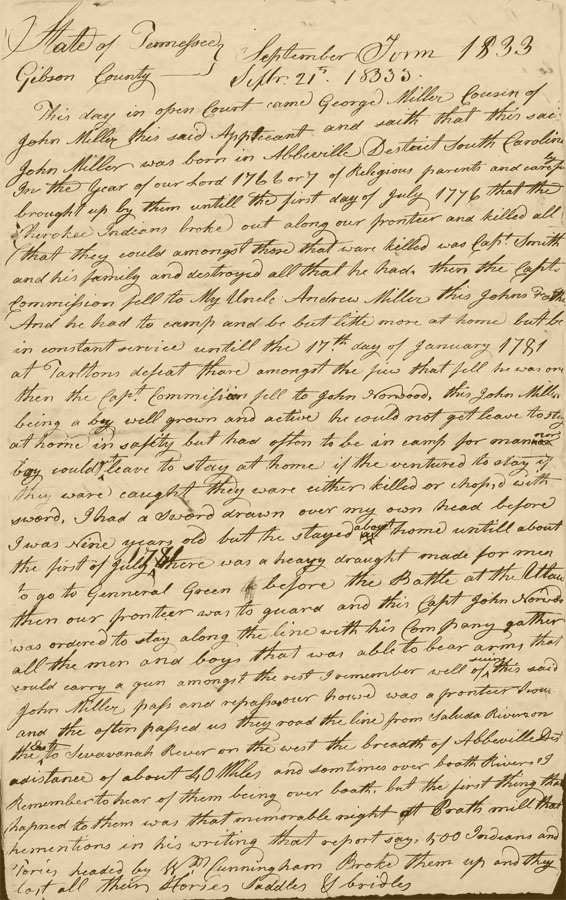
George Miller sworn statement dated September 21, 1833 (page 1).
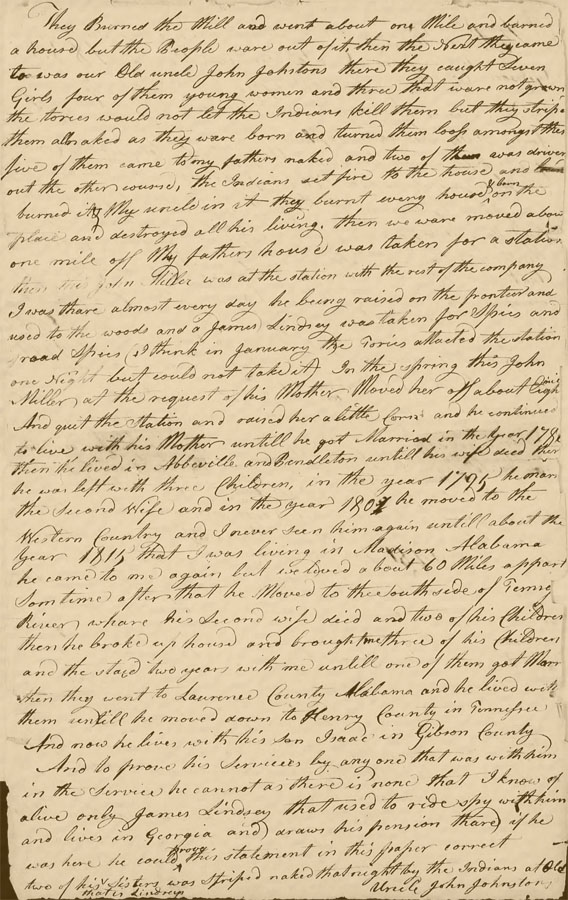
George Miller sworn statement dated September 21, 1833 (page 1).
On October 19, 1781, the British army under General Cornwallis had surrendered to General Washington at Yorktown, Virginia. Yet the bitter vindictive fighting between the colonial settlers in the back country of South Carolina continued. In early November, Captain William Cunningham was promoted to major and given official command of an 84 man regiment of British loyalist. On November 17, “at day-break” Major William Cunningham’s men attacked a company of Patriot militia “posted in a house on Cloud’s Creek” (east of present-day Saluda near Lick Creek & about 50 miles from Miller’s Station). Under the command of Captain Sterling Turner, the patriots provided “an obstinate resistance of an hour“.[16] Low on ammunition and with two men killed, Captain Turner and his remaining men were forced to surrender.
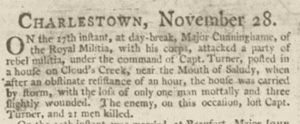
The Royal Gazette (Charleston, South Carolina) dated November 24, 1781, Page 3.
Major William Cunningham believed at least two of the patriots had killed loyalist (James Butler, Jr was believed to have killed Captain Ratcliffe & William Butler was believed to have killed Sergeant MacAllister). Captain Turner and Captain James Butler (Sr) surrendered first and were cutdown by the sword of Major William Cunningham and the other “Tories” joined in until at least 23 patriots were hacked into pieces.[17] Only Benjamin Hughes and Bartlett Bledsoe are believed to have escaped.
Having earned the title of “Bloody Bill“, Major Cunningham moved on from Cloudy Creek to “Ensley’s shop” when he captured and hanged John Towles who had served as a captain in the militia.[18] The marauding band next arrived at the blacksmith shop of Oliver Towles. Oliver Towles had served with Cunningham as a sergeant under Captain John Caldwell in Colonel Thompson’s Regiment of Rangers (South Carolina 3rd Regiment) prior to being promoted to Captain.[19] After Oliver Towles had shod the loyalist horses, Major “Bloody Bill” Cunningham and his men killed Oliver Towles, his son, and a young Negro boy. The “Tories” set fire to all the buildings as they rode on.[20]
Major “Bloody Bill” Cunningham and his marauders proceeded next to the home of the now retired Major John Caldwell (his brother Major William Caldwell’s land was adjacent to the land of Oliver Towles & Thomas Edgehill). In front of his men, “Bloody Bill” Cunningham road up to the gate of the house and his former commander walked out to meet him. “Bloody Bill” Cunningham “drew a pistol and shot him dead in the presence of his wife, who fainted as she saw him fall” and then burn his house. Major John Caldwell and his brother Major William Caldwell (a member of the First Provincial Congress of South Carolina) were both uncles of a young John C. Calhoun (would become the Vice President from 1825-1832).[21]
- Major William Caldwell was the father of Margaret Caldwell, the wife of James Richey (Sr), and mother of John Caldwell Richey (Sr). About 1773, John Caldwell Richey (Sr) had married the niece of James Brownlee**(1735), Nancy Ann Brownlee.
After killing Caldwell, Major “Bloody Bill” Cunningham’s band had swelled to 150 loyalist. On November 19, 1781, Major “Bloody Bill” Cunningham’s band attacked the patriot militia company posted at “Hayes’ Station“. Located east of Little River and Simmon’s Creek (about 35 miles from Miller’s Station), Colonel Joseph Hayes had seized the “Edgehill” plantation from British Loyalist Colonel Thomas Edgehill.[22] After Colonel James Williams was killed at Kings Mountain, Colonel Joseph Hayes had assumed command of the patriots “Little River” militia.[23]
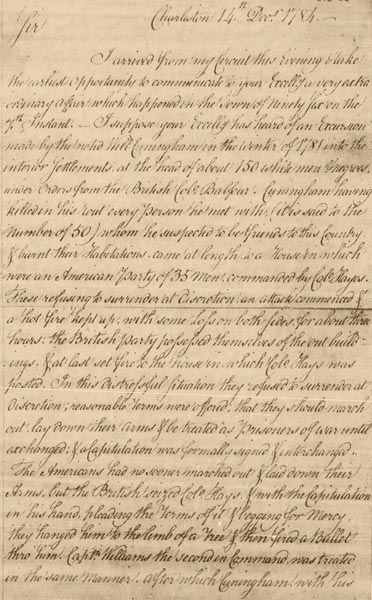
First page of letter from Judge Aedanus Burke dated December 14, 1784 (South Carolina Department of Archives, Series: S165009, Message: 313)
Despite having been warned by his neighbor (Major ?) William Caldwell of a pending attack, Colonel Joseph Hayes and his men were taken by surprise and quickly surround in a small long house. The son of the deceased Colonel Williams, Major Daniel Williams reportedly shot and killed one of the loyalist and two of Hayes’ men were killed before the loyalist were able to set the roof on fire. Overcome by the heavy black smoke, Colonel Joseph Hayes and his remaining men agreed to surrender “on the promise of good quarter“.[24]
Likely remembering Hammond’s Store, Major “Bloody Bill” Cunningham ordered Colonel Joseph Hayes and Major Daniel Williams immediately hanged. His 16-17 year-old brother, Joseph Williams cried out “Oh brother Daniel, what will I tell mother?“. Although he had known the boy since he was an infant, “Bloody Bill” Cunningham responded “You will tell her nothing” as he killed him with his saber and then led his men to hack to death the remaining prisoners (at least 18 men). Major William Dunlap, Captain William Millwee, James Tinsley, John Cummins, and possibly John Mangum (neighbor of Colonel Joseph Hayes) are the only patriots known to have been able to escape the melee.[25]
- The niece of James Brownlee**(1735), Alice Brownlee, is believed to have been married to Colonel Joseph Hayes and living at Hayes Station.
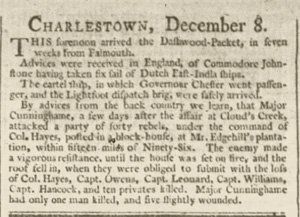
The Royal Gazette (Charleston, South Carolina) dated December 5, 1781, Page 3.
After slaughtering the “Little River” company at Hayes’ Station, Major “Bloody Bill” Cunningham and his marauding band dispersed. Near Duncan Creek (east of Miller’s Station near present-day Whitmire), several of the British Loyalist were captured and “speedy justice was administered” as they were hanged “where Charleston road crossed the main road to Ninety-Six“.[26] Major “Bloody Bill” Cunningham moved north where he reportedly murdered James Wood (the Commissioner of sequestered properties), his brother John Wood, at their homes along with shooting Captain Stedman as he laid sick in the house of Charles Moore.[27]
On or about December 5-7, 1781, Captain John Crawford led a detachment of Colonel Hezikiah Williams’ British Loyalist along with Cherokee warriors on an attack of the Patriot militia company station at White Hall. Locate just a few miles southeast of Miller’s Station, White Hall was the plantation of General Andrew Williamson. After forcing the militia to abandon their fortifications, the “Tories” destroyed them and quickly moved on to the nearby Andrew Pickens “blockhouse” (a Patriot supply depot near present-day Abbeville).[28] Around this same time, Loyalist had attacked Miller’s Station “one night but could not take it“.[29]
Just east of McCord Creek and south of Miller’s Station, Captain John Crawford’s band surprised a patriot militia company (including Hezekiah Posey) under the command of Captain Moses Liddell that was escorting a train of wagons sent out for supplies (they were out of corn). Several of his men were killed (including Enos Crawford & Hugh Porter)[30] and Captain Moses Liddell’s company was force to abandon the wagons. The loyalist captured the drivers and burned seven wagons prior to escaping into the Cherokee territory where the captives were believed to have been killed in ceremonial fires. One of the captured drivers killed by the Cherokee, John Pickens, was the brother of General Andrew Pickens and had been a neighbor of John Crawford in the Long Cane settlement prior to the revolution.[31]
Hezekiah Posey (brother of Richard Posey**) was “shot through the left shoulder and arm by the first gun which was fired” However, he was able to escape when “he jumped on his horse in haste“. After riding a short distance, Hezekiah Posey “was met by a good man who took him and hid him in the woods where he remained until & dark“. With the help of two ladies and a boy, he was taken to his relatives and “his wounds were there dressed by his Brother & was the next day taken… Doctor Harriss where he remained” until he recovered.[32]
- Captain Moses Liddell was the brother of George Liddell. Both Mose Liddell and John Norwood were named executors by George Liddell when the 35 year-old Patriot died in 1789. John Miller (1748) would marry George Liddell’s widow (Rachel Liddell) on March 27, 1794.
- Captain Moses Liddell had commanded a company of mounted militia in the rout of the British loyalist at Hammond’s Store on December 29, 1780.
Although the British retained firm control of Charleston, the South Carolina General Assembly was convened by the patriots in Jacksonborough on January 8, 1782. Largely comprised of men that had fought the British Loyalist (including Colonel Robert Anderson, Colonel LeRoy Hammond, & General Andrew Pickens), the South Carolina General Assembly passed the “Confiscation Acts” on February 26, 1782. Legalizing retribution against British Loyalist, the “Confiscation Acts” named estates to be seized and “Banished Certain Persons therein mentioned” including commissioned officers and “Obnoxious persons“.[33] The initial list (the list would be revised several times), which included William Cunningham and Robert Cunningham, was provided to the British and published in the Royal Gazette on March 20, 1782.
Captain John Norwood would continue to command the company of militia “rangers” at Miller’s Station until the spring of 1783. The company patrolled along the Little River and head of Long Cane creek for Indians and “Tories“. During this time, the “Little River” militia company included Lt. Hugh Reid, Lt. John Caldwell, Sergeant John Hunt, privates John Miller (the son of John Miller’s brother Andrew), Trius (Travis?) Harbison, James Thompson, Thomas Lacy, John Lindsay, James Hathhorn, Andrew Webb, Isaac Thatcher, Martin Miller, Andrew Watt, Samuel McMustre, Thomas Watt, John Casson, William Perry, John Fox Senior, John Fox Jr., William Pratt, Samuel Lindsay, James Lindsay, Ephraim Lindsay, Nathaniel Bailey, Robert Ellis, John Verner, and James Stevenson (John Miller’s brother-in-law?).[34]
- Samuel Lindsay (Lindsey) was the father of John Lindsay, who would marry Elizabeth Brownlee (the daughter of James Brownlee-1735).
In 1782 until the spring of 1783, Captain Norwood’s company was not known to have killed any Indians. However, the company did reportedly kill three British Loyalist (John Masterson, Thomas Neil, & Andrew “Andy” Neil) while sparing the life of another (John McCamy/McCay) as “he being young“.[35] A British Loyalist, John Masterson (Materson/McMesterson) was known to have served with “Bloody Bill” Cunningham in the British Loyalist “Little River” militia under Captain John Cunningham and Major Patrick Cunningham in 1780; and a Captain John Masterson (with Captain John Crawford & Captain John Harris Tyner) served under Colonel Hezekiah Williams’ Loyalist Regiment in 1782. Captain Thomas Neal led a small six man company of the Ninety-Six Loyalist in 1781-1782; and Lieutenant Andrew “Andy” Neal served with Captain John Crawford in King’s Loyalist Regiment of Lone Cane militia in 1780.[36]
- John Norwood, Patrick John McMesterson, John Crawford, Enos Crawford, John Lindsay, Samuel Lindsay, John Miller, Andrew Miller, Hugh Read (Reid), James Stevenson, Caleb Tiner (Tyner), John Johnson, John Brownlee, James Brownlee, Francis Johnston (Johnson), John Calhoun, John Pickens, and Andrew Pickens, were all included in the 1778-1779 Petit-Jury List for “Long Canes and Places Adjacent” for the Ninety-Six District of South Carolina.[37]
- Prior to the revolution, Andrew Neil was a neighbor of the John Miller and Andrew Miller.
For killing John Masterson, “a notorious and mischievous Enemy of the Country“, Captain John Norwood was given a confiscated slave as a reward (a common practice) in May 1782. Alexander Chaves would file a petition claiming the slave was his and requesting restitution in 1794. The court denied the claim due to “the times limits by law” for filing the claim had expired.[38] Following the raid of “Bloody Bill” Cunningham, the leaders of the British Loyalist were alarmed at the “retributions” taken against their brethren in the South Carolina backcountry. On April 19, 1782, eleven British loyalist signed a petition naming nearly 300 British Loyalist they believed had been “murdered” in South Carolina by members of the “natural rebellion“.[39] In the end, more South Carolinians would be killed by each other than were killed in all the armed conflicts in the colony between British and American military forces.
In August 1782, General Andrew Pickens was encamped at Long Cane (a few miles southwest of Miller’s Station) as he prepared for his second campaign against the Cherokee Indians of the year. Foraging supplies for General Pickens, Captain John Norwood provided a receipt for supplies (beef) provided by George Brownlee (1756).[40] Between March-April, General Pickens’ 275 man brigade reportedly killed 40 Cherokee Indians and burned thirteen villages along the Hiwassee River (Tennessee) prior to returning to Long Cane in June 1782.

- The son of James Brownlee (1735), George Brownlee** (1756) would marry Sarah Caldwell sometime around 1787. Sarah Caldwell is believed to be the daughter of William Caldwell.
Over time the bitterness from the fighting would be forgotten in the community of Due West. Promoted to general of the militia, John Norwood ensured the payments (called “indents”) went to the widows of Andrew Miller, Francis Johnson, and others killed in the fight for independence. In his 1798 will, General John Norwood named “my good & trusty friends John Miller, Hugh Reid, & William Cunningham” (a relative of “Bloody Bill“) executors of his estate (see below).[41] With no historical marker for John Miller’s farm, it would be the bond of “good & trusty friends” who fought for survival at Miller’s Station that would prevail.

Clipped from the will and probate papers of General John Norwood (Abbeville County Probate Records, Box 78, Package 1722).
God Bless!
[1] Documentary history of the American revolution (1764-1776) edited by R.W. Gibbes M.D., Pages 179-180; Copy of original Declaration of Ninety Six District Inhabitants dated September 12, 1775 (South Carolina Archives Series: S213089, Box: 2, Folder: 6).
[2]Roster of South Carolina Patriots in the American Revolution by Bobby Gilmer Moss, Page 679, & 896; The South Carolina Historical Magazine, Volumes 1-2, Pages 296-297.
[3]Sworn Statement John Miller’s son (George Miller) supporting the Revolutionary War Pension Application of John Miller’s nephew John Miller (son of John Miller’s brother Andrew Miller) #S1702. Roster of South Carolina Patriots in the American Revolution by Bobby Gilmer Moss, Page 679. Sworn Statement of Aaron Smith (son of Captain Aaron Smith) dated July 1, 1776, American Archives compiled by Peter Force, Pages 1228-1229.
[4]Failure and the King’s Cause on the Southern Revolutionary War Frontier by Robert Scott Davis.
[5]Loyalists in the Southern Campaign of the Revolutionary War compiled by Murtie June Clark, Pages 46, 224, 246, & 291.
[6]Revolutionary War Pension Application of James Stephenson W#9685.
[7]The Royal Gazette, September 12, 1781; South Carolina Loyalist in the American Revolution by Robert Stansbury Lambert, Page 148.
[8]South Carolina Loyalist in the American Revolution by Robert Stansbury Lambert, Page 147.
[9]Random Recollections of Revolutionary Characters and Incidents by J.B. O’Neal in The Southern Literary Journal and Magazine of Arts, July 1838, Vol. 4, Pages 40-41.
[10]Revolutionary War Pension Application of Francis Johnson (Johnston) #W21805.
[11]Sworn Statement John Miller’s son (George Miller) supporting the Revolutionary War Pension Application of John Miller’s nephew John Miller (son of John Miller’s brother Andrew Miller) #S1702; Indents issued in payment of claims against South Carolina growing out of the Revolution. No. 226 Book K; Roster of South Carolina Patriots in the American Revolution by Bobby Gilmer Moss, Page 135.
[12]The Royal Gazette, September 24, 1781; Sworn statement by John R. Ridgeway dated September 1, 1787; Accounts Audited of Claims Growing Out of the Revolution File No. 6416 (South Carolina Department of Archives, Series: S108092, Reel: 125, Frame: 16).
[13]Memoir of Major Thomas Young, Orion Magazine, October-November 1843; Stand and Face the Morning by Helen S. Owens, Page 419.
[14]Revolutionary War Pension Application of John Miller (son of John Miller’s brother Andrew Miller) #S1702.
[15]Sworn Statement John Miller’s son (George Miller) supporting the Revolutionary War Pension Application of John Miller’s nephew John Miller (son of John Miller’s brother Andrew Miller) #S1702.
[16]Royal Gazette Wednesday, November 28, 1781; Death Notices compiled by Marvel L. Weber, The South Carolina Historical and Genealogical Magazine, Vol. 17, No. 4 (October 1916), Pages 161-162.
[17]Random Recollections of Revolutionary Characters and Incidents by J.B. O’Neal in The Southern Literary Journal and Magazine of Arts, July 1838, Vol. 4, Page 42.
[18]Colonial and Revolutionary History of Upper South Carolina by John Belton O’Neall Landrum, Pages 348-349. Ramsay’s History of South Carolina by David Ramsey, Page 257.
[19]Roster of South Carolina Patriots in the American Revolution by Bobby Gilmer Moss, Page 937.
[20]Andrew Pickens: South Carolina Patriot in the Revolutionary War
by William R. Reynolds, Jr; Page 293.
[21]Colonial and Revolutionary History of Upper South Carolina by John Belton O’Neall Landrum, Page 349.
[22]Random Recollections of Revolutionary Characters and Incidents by J.B. O’Neal in The Southern Literary Journal and Magazine of Arts, July 1838, Vol. 4, Page 43.
[23]Encyclopedia of War and American Society edited by Peter Karsten, Page 1027.
[24]Royal Gazette, Saturday, December 8, 1781; Andrew Pickens: South Carolina Patriot in the Revolutionary War by William R. Reynolds, Jr; Page 294. Random Recollections of Revolutionary Characters and Incidents by J.B. O’Neal in The Southern Literary Journal and Magazine of Arts, July 1838, Vol. 4, Page 43.
[25]Royal Gazette, Saturday, December 8, 1781; Andrew Pickens: South Carolina Patriot in the Revolutionary War by William R. Reynolds, Jr; Page 294. Random Recollections of Revolutionary Characters and Incidents by J.B. O’Neal in The Southern Literary Journal and Magazine of Arts, July 1838, Vol. 4, Page 43; John Mangum American Revolutionary War Soldier and Descendants by Delta Ivie Mangum Hale, Pages 7-16; Revolutionary War Pension Application of William Millwee #W9200; Petition And Supporting Papers Requesting Reimbursement For Losses Sustained During His Military Service In The American Revolution of William Millwee (South Carolina Archives Series: #S108092, Reel: 0105, Frame: 00359); “Random Recollections of Revolutionary Characters and Incidents” Western Carolinian (Salisbury, North Carolina) dated August 17, 1838, Page 1.
[26]Colonial and Revolutionary History of Upper South Carolina by John Belton O’Neall Landrum, Pages 351-352.
[27]History of the Presbyterian Church in South Carolina, Volume 1, by George Howe, Pages 437-438.
[28]Royal Gazette, Wednesday, January 2, 1782. South Carolina Revolutionary Battles, Part Seven by Terry W. Lipscomb, Pages 37-39.
[29]Sworn Statement John Miller’s son (George Miller) supporting the Revolutionary War Pension Application of John Miller’s nephew John Miller (son of John Miller’s brother Andrew Miller) #S1702.
[30]Logan Manuscript, Historical Collections of the Joseph Habersham Chapter, Daughters American Revolution, Volume III; Calhoun, Hamilton, Baskin, and related families by Lewin Dweinell McPherson, Page 210.
[31]Royal Gazette, Wednesday, January 2, 1782; Andrew Pickens: South Carolina Patriot in the Revolutionary War by William R. Reynolds, Jr, Pages 294-295; The Cherokee Struggle to Maintain Identity in the 17th and 18th Centuries by William R. Reynolds, Jr, Pages 215-216. Roster of South Carolina Patriots in the American Revolution by Bobby Gilmer Moss, Page 772; Calhoun, Hamilton, Baskin, and related families by LewinDweinell McPherson, Page 210.
[32] Revolutionary War Pension Application of Hezekiah Posey (brother of Richard Posey**) #S14192.
[33]Journal of the House of Representatives of South Carolina, Pages 121-134.
[34]Revolutionary War Pension Application of Robert Ellis #S26084; Revolutionary War Pension Application of James Stevenson #W9585; Revolutionary War Pension Application of John Verner #S7793; John Caldwell Account Audited (File No. 990) Of Claims Growing Out Of The American Revolution (South Carolina Archives).
[35]Revolutionary War Pension Application of Robert Ellis #S26084; Revolutionary War Pension Application of John Verner #S7793.
[36]Loyalists in the Southern Campaign of the Revolutionary War compiled by Murtie June Clark, Page 225, 264, 223, & 289.
[37]The Jury Lists of South Carolina (1778-1779), Page 83-86.
[38]Petition of Alexander Chaves (Chavis) dated December 12, 1793, South Carolina Department of Archives, Series: S165015, Item: 114.
[39]Petition to Lord Germain Dated 19 April 1782.
[40]South Carolina Department of Archives, Series S108092, Reel 15, Frame 220 (File No. 834); Roster of South Carolina Patriots in the American Revolution by Bobby Gilmer Moss, Page 113.
[41] Original Will of General John Norwood dated January 22, 1798 (Abbeville County Probate, Box 78, Page 1722).